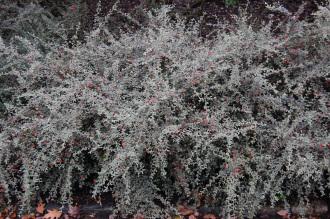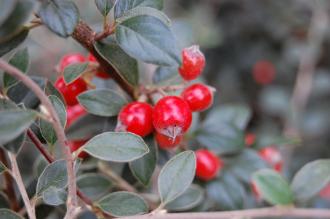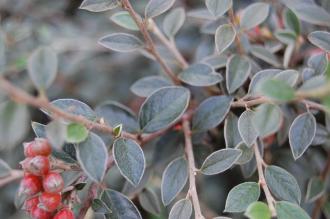
Cotoneaster buxifolia (21/10/2013, Kew Gardens, London)
Position: Full sun to dappled shade
Flowering period: Late spring to early summer
Soil: Moist, well drained
Eventual Height: 2m
Eventual Spread: 3m
Hardiness: 6b, 7a, 7b, 8a, 8b, 9a, 9b, 10a
Family: Rosaceae
Cotoneaster buxifolia is an evergreen shrub with a spreading, mounding habit. Its dark green leaves are covered in a fine felt, elliptic with entire margins, up to 25mm long and 15mm broad. Its white flowers are up to 8mm across. Its red fruit are pomes, up to 6mm across, mature in early autumn and may be retained on the plant during the winter months.

Cotoneaster buxifolia Berries (21/10/2013, Kew Gardens, London)
Cotoneaster buxifolia, commonly known as Rock Spray or Box Leaf Cotoneaster, is native to the Nilgiri Hills, south India.
The etymological root of the binomial name Cotoneaster is derived from the old Latin name cotone meaning ‘quince and aster being a Latin substantival suffix indicating ‘resembling’. Buxifolia is derived from Buxus, another evergreen shrub and the Latin folium
When available, the landscape architect may find Cotoneaster buxifolia useful as an evergreen shrub with attractive winter berries.
Ecologically, Cotoneaster buxifolia flowers are attractive to pollinating insects. Its berries are attractive to birds.

Cotoneaster buxifolia Leaf (21/10/2013, Kew Gardens, London)
Cotoneaster buxifolia prefers moist, fertile, well-drained soils. It tolerates most pH of soil.
Cotoneaster buxifolia requires little maintenance.

